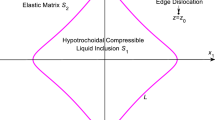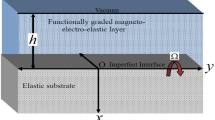Abstract
This paper studies surface tension-induced stress concentration around a nanosized hole of arbitrary shape inside an elastic half-plane. Of particular interest is the maximum hoop stress on the hole’s boundary with relation to the point of maximum curvature and the distance between the hole and the free surface of the half-plane. The shape of the hole is characterized by a conformal mapping which maps the exterior of the hole onto the exterior of the unit circle in the image plane. On using the technique of conformal mapping and analytic continuation, the complex potentials of the half-plane are expressed in a series form with unknown coefficients to be determined by Fourier expansion method. Detailed numerical results are shown for elliptical, triangular, square and rectangular holes. Two basic conclusions are that the hoop stress increases with decreasing hole size and the maximum hoop stress generally appears nearby but not exactly at the point of maximum curvature. In addition, it is shown that the hoop stress nearby the point of maximum curvature on the hole’s boundary increases rapidly with decreasing distance between the hole and the free surface of the half-plane. On the other hand, if the distance between the hole and the free surface is more than three times the hole size, the effect of the free surface on the stress concentration around the hole is ignorable and the elastic half-plane can be treated approximately as an elastic whole plane.










Similar content being viewed by others
References
Muskhelishvili NI (1975) Some basic problems of the mathematical theory of elasticity. Noordhoff, Groningen
Savin GN (1961) Stress concentration around holes. Pergamon Press, London
Eshelby JD (1957) The determination of the elastic field of an ellipsoidal inclusion and related problems. Proc R Soc Lond A 241:376–396
Eshelby JD (1959) The elastic field outside an ellipsoidal inclusion. Proc R Soc Lond A 252:561–569
Wong EW, Sheehan PE, Lieber CM (1997) Nanobeam mechanics: elasticity, strength, and toughness of nanorods and nanotubes. Science 277:1971–1975
Miller RE, Shenoy VB (2000) Size-dependent elastic properties of nanosized structural elements. Nanotechnology 11:139–147
Shenoy VB (2002) Size-dependent rigidities of nanosized torsional elements. Int J Solids Struct 39:4039–4052
Sharma P, Ganti S, Bhate N (2003) Effect of surfaces on the size-dependent elastic state of nano-inhomogeneities. Appl Phys Lett 82:535–537
Sharma P, Ganti S (2004) Size-dependent Eshelby’s tensor for embedded nano-inclusions incorporating surface/interface energies. ASME J Appl Mech 71:663–671
Gurtin ME, Murdoch AI (1975) A continuum theory of elastic material surfaces. Arch Ration Mech Anal 57:291–323
Gurtin ME, Murdoch AI (1978) Surface stress in solids. Int J Solids Struct 14:431–440
Gurtin ME, Weissmuller J, Larché F (1998) A general theory of curved deformable interfaces in solids at equilibrium. Philos Mag A 78:1093–1109
Tian L, Rajapakse RKND (2007) Analytical solution for size-dependent elastic field of a nanoscale circular inhomogeneity. ASME J Appl Mech 74:568–574
Tian L, Rajapakse RKND (2007) Elastic field of an isotropic matrix with a nanoscale elliptical inhomogeneity. Int J Solids Struct 44:7988–8005
Wang GF, Wang TJ (2006) Deformation around a nanosized elliptical hole with surface effect. Appl Phys Lett 89:161901–161903
Zeng XW, Wang GF, Wang TJ (2011) Erratum: “Deformation around a nanosized elliptical hole with surface effect” [Appl. Phys. Lett. 89, 161901 (2006)]. Appl Phys Lett 98:159901–159902
Fang XQ, Zhang LL, Liu JX (2013) Dynamic stress concentration around two interacting coated nanowires with surface/interface effect. Meccanica 48:287–296
Anjomshoa A (2013) Application of Ritz functions in buckling analysis of embedded orthotropic circular and elliptical micro/nano-plates based on nonlocal elasticity theory. Meccanica 48:1337–1353
Shen H, Schiavone P, Ru CQ, Mioduchowski A (2000) An elliptic inclusion with imperfect interface in anti-plane shear. Int J Solids Struct 37:4557–4575
Luo JC, Gao CF (2011) Stress field of a coated arbitrary shape inclusion. Meccanica 46:1055–1071
Krylov VI, Kantorovitch LV (1958) Approximate methods of higher analysis. Wiley Interscience, London
Radok JRM (1955) Problems of plane elasticity for reinforced boundaries. ASME J Appl Mech 77:246–254
Zou W, He Q, Huang M, Zheng Q (2010) Eshelby’s problem of non-elliptical inclusions. J Mech Phys Solids 58:346–372
Acknowledgments
Dai and Gao thank the support from the National Natural Science Foundation of China (11232007) and a Project Funded by the Priority Academic Program Development of Jiangsu Higher Education Institutions(PAPD), and Ru thanks the support from the Natural Science and Engineering Research Council of Canada (NSERC-RGPIN204992).
Author information
Authors and Affiliations
Corresponding author
Appendix
Appendix
1.1 Proof of the mapping Eq. (9)
Firstly, since the conformal mapping function (8) is bijective, there exist one-to-one corresponding z 1 and ξ 1 satisfying
Let z 2 and ξ 2 be the conjugates of z 1 and ξ 1, respectively. So according to the conjugate of Eq. (35), the one-to-one corresponding z 2 and ξ 2 satisfy
which shows that the mapping function (9) is bijective from the exterior of the unit circle in the ξ 2-plane to Ω2 in the z-plane.
Then, the derivative of the conformal mapping function (8) should satisfy
which means
Conjugating Eq. (38) leads to
Finally, one can conclude from Eqs. (36) and (39) that Eq. (9) is a mapping from the exterior of the unit circle in the ξ 2-plane to Ω2 in the z-plane.
1.2 Derivation of the curvature K
In the z-plane, the point-wise coordinates (x, y) on Γ1 can be written in terms of ω(σ) as
The first and second order derivatives of x and y with respect to θ can be expressed as
Finally, the signed curvature K can be given by the curvature formula as
Rights and permissions
About this article
Cite this article
Dai, M., Gao, CF. & Ru, C.Q. Surface tension-induced stress concentration around a nanosized hole of arbitrary shape in an elastic half-plane. Meccanica 49, 2847–2859 (2014). https://doi.org/10.1007/s11012-014-0030-y
Received:
Accepted:
Published:
Issue Date:
DOI: https://doi.org/10.1007/s11012-014-0030-y




